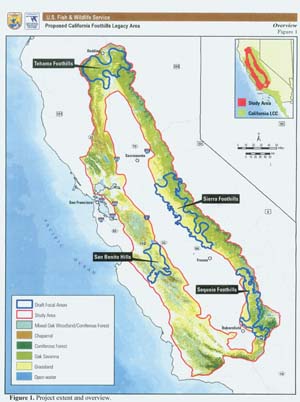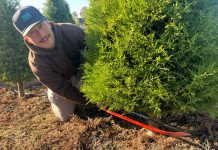
A massive federal government land-conservation plan carries
potential to affect about half of San Benito County’s total
acreage
– nearly 500,000 acres locally and 3.4 million statewide – while
aiming to set aside rangeland deemed as crucial habitat for
threatened and endangered species, according to a U.S. Fish and
Wildlife Service document.
A massive federal government land-conservation plan carries potential to affect about half of San Benito County’s total acreage – nearly 500,000 acres locally and 3.4 million statewide – while aiming to set aside rangeland deemed as crucial habitat for threatened and endangered species, according to a U.S. Fish and Wildlife Service document.
The “California Foothills Legacy Area” proposal involves the offering of land easements to willing property owners. The federal government would pay those residents in exchange for maintaining their properties’ agricultural activities while forbidding development and working to help preserve nearly 200 endangered or threatened species identified as likely inhabiting the rangeland.
Seven years in the making but only recently published, the proposal designates an enormous swath of the Central Valley – affecting portions of 26 counties – as a “study area” encompassing around 18 million acres.
From that study area, the fish and wildlife service narrowed the examination into four “focal areas” – or pockets within the larger swath. Those focal areas include the 3.4 million acres of rangeland under consideration for easements – 489,479 acres in San Benito County, with 93 percent privately owned.
For now, the federal agency has a goal of conserving a total of 900,000 acres in the entire study area – the four focal areas are preliminary targets as well – but it could consider setting aside more land in the future or eliminating the idea altogether, said Mark Pelz, chief of refuge planning for the U.S. Fish and Wildlife Service. The initial, estimated cost is $900 million.
To put the potential local impact into perspective, San Benito County as a whole includes 893,440 acres – 767,000 of which are privately owned, according to the county assessor’s office.
California as a whole has just 123,933 acres with easements maintained by the U.S. Fish and Wildlife Service. A majority of those properties are on wetlands in the Central Valley near Los Banos and Modesto, Pelz said.
Potentially affected property owners would have some time to consider the program. The proposal is merely entering its scoping phase, and there are six public meetings scheduled for June in the affected areas – including Hollister from 6 p.m. to 8 p.m. June 16 at the Veterans Memorial Building.
The planning process is expected to take at least 18 months.
“We want to hear what we’ve missed or if there are other lands that need protection,” Pelz said.
San Benito County Agricultural Commissioner Ron Ross sees a benefit for the community – but only if it’s done right.
“It could be a really good thing for the ranching heritage of the county, but it needs to be done right,” Ross said.
To do so, Ross believes landowners and ranchers still must control how they farm and cultivate – with few restrictions.
“We still need to find these things out,” Ross said. “Right now, I don’t know what they are up to.”
According to a California Foothills Legacy Area document obtained by the Free Lance, it is a conservation initiative aimed at saving rangeland important to migratory birds, endangered species and oak woodlands, from risk of a growing state population.
The focal areas are designated as the Tehama Foothills, the Sierra Foothills, the Sequoia Foothills and the San Benito Hills.
“Foothill rangelands and the species on which they depend persist today because of the responsible land stewardship practices of ranchers who own these lands,” according to the plan. “Maintaining a strong and viable ranching community that keeps working lands working will help protect important habitats and wildlife movement corridors.”
The precise effect on each area in the easement plan is unknown because the proposal remains in flux awaiting input from local communities, Pelz said.
As for the 18 million acres encompassing the entire study area, it is made up of the so-called “California Landscape Conservation Cooperative” that runs along the state’s Central Valley, Pelz noted.
“They are just that – preliminary,” Pelz said. “We are still in the planning process so we want to make sure we have the right areas and there are no areas missing.”
He continued, “During the scoping process, it could change.”
No easement land restrictions have been drafted and would need to be worked out once the project’s “focal areas” are officially narrowed, Pelz said.
“There are still a lot of details to be worked out,” he said. “We haven’t worked out a specific plan just yet, but I don’t see us looking into putting a restriction on the amount of cattle you have.”
If approved, landowners in the focal areas would have the opportunity to take part in the voluntary easement with unclear restrictions on the properties, Pelz said.
“It’s a willing seller program, so they don’t have to take part in it,” he said. “If they don’t want to, there is nothing we can do about it.”
If landowners agree to the easements, they would receive funds based on property values, according to proposal. The federal government estimated payments of $1,000 per acre, with the total cost of $900 million.
The “primary source of funding” for the project would come from the Land and Water Conservation Fund, with additional money from the Migratory Bird Conservation Fund, according to the proposed plan.
The funds are allocated by Congress every year and are readily available, Pelz said. A major source of the money is royalties on oil rigs.
“It’s not from tax revenue,” he contended.
The proposal notes how the California Foothills Legacy Area plan was created from a partnership between the Fish and Wildlife Service and more than 100 agricultural organizations and environmental groups, including the California Cattleman’s Association, the California Farm Bureau Federation and the Defenders of Wildlife.
Look back for more, including reaction. To learn more about the proposal, go here.









